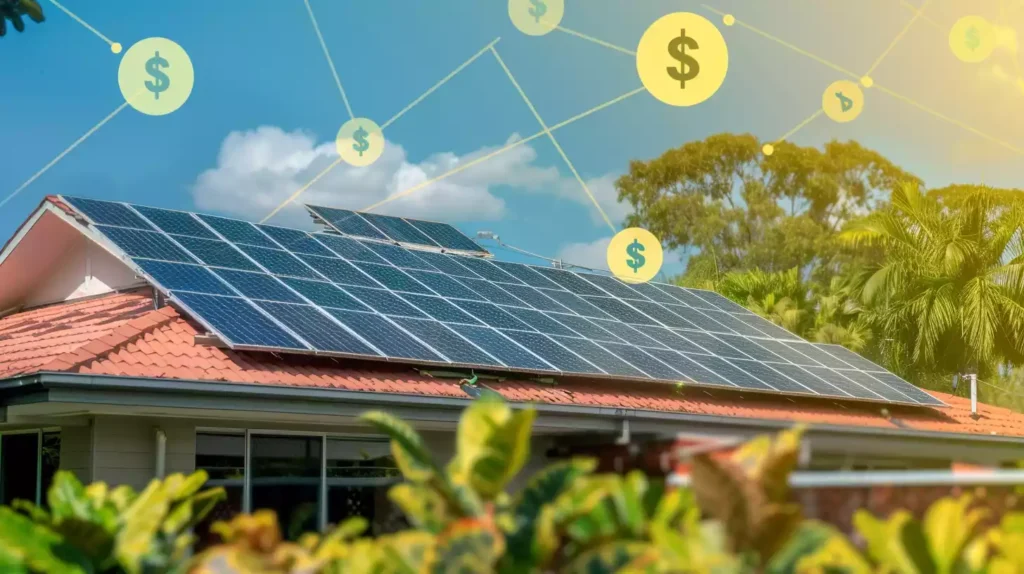How Long Do Solar Panels Take to Pay for Themselves?
Solar panels typically take 6 to 12 years to recoup their costs, influenced by location, incentives, and energy expenses. Moderate your enthusiasm to witness returns, as this timeframe is crucial for sustainability and long-term savings.
Are you prepared to ponder elements like efficiency and savings to optimize your investment journey? Keep in mind, the journey of your solar panels paying for themselves is just the beginning of a brighter financial future.
Let’s investigate how strategic choices can shorten this payback window and enhance your solar power benefits.
Main Points Covered Below
- Factors include installation cost, incentives, panel quality, lifespan, and home value impact.
- ROI compares system cost to annual savings, influenced by energy production and quality.
- Payback period varies from 6 to 12 years in the US, influenced by location and incentives.
- Aim for a payback period below 12.5 years, aligning with the 25-year panel lifespan.
- Understanding IRR helps evaluate solar panel investment value and optimize returns.

Factors Influencing Solar Panel Payback Time
When contemplating solar panel payback time, several key factors greatly influence the overall duration. One essential aspect is the initial installation cost, which impacts how long it takes to recoup the investment.
Incentives also play a significant role in reducing the payback period, as they directly lower the overall cost of the system. Furthermore, the quality and efficiency of the solar panels themselves affect how quickly you start seeing returns on your investment.
Higher quality panels with better efficiency can generate more electricity, leading to increased savings on electricity bills and a shorter payback period.
Another important factor to take into account is the lifespan of the panels. Modern PV solar panels have a lifespan of at least 25 years with 80% efficiency, ensuring a longer duration of savings after the payback period.
Lastly, the potential increase in home value due to solar panels can also impact the overall financial picture positively. These factors together influence the solar panel payback period, making it crucial to evaluate them all when assessing the investment.
Calculating Solar Panel ROI
When it comes to calculating solar panel ROI, there are key points to ponder:
- The methods used for ROI calculation
- The factors that influence the ROI outcome
- Setting realistic expectations for your return on investment
Understanding these aspects is vital for making informed decisions about investing in solar energy.
ROI Calculation Methods
Calculating the return on investment (ROI) for solar panels involves comparing the total system cost to the annual savings generated. Factors like energy production, incentives, and system quality impact solar panel ROI, typically ranging from 10% to 30% in the U.S. This percentage varies based on location and specific home characteristics.
A higher ROI signifies a more financially beneficial solar panel installation over its lifespan. Understanding the ROI of solar panels is essential for making informed decisions regarding investing in renewable energy.
Factors Affecting ROI
Factors like location, incentives, system quality, and electricity costs greatly influence the return on investment (ROI) for solar panels. When calculating ROI for solar panels, it’s crucial to take into account these key elements:
- Location: The amount of sunlight your area receives impacts energy production and, consequently, ROI.
- Incentives: Government rebates, tax credits, and other incentives can greatly reduce the upfront solar panel cost.
- System Quality: Investing in high-quality solar panels guarantees better efficiency and longer lifespan, impacting long-term savings.
- Electricity Costs: Higher electricity prices make solar panels more financially attractive, leading to quicker payback periods.
Understanding how these factors interact can help estimate energy savings, calculate ROI, and make informed decisions about installing solar panels.
Realistic ROI Expectations
Considering the realistic ROI expectations for solar panels involves understanding the potential returns and factors influencing the investment outcome.
Solar panels reduce electricity costs through savings generated over time. The average payback period, typically 9 to 12 years, is influenced by factors like solar payback period, net metering, and solar savings estimates.
Calculating solar panel ROI includes considering the initial cost, ongoing savings, and potential incentives available. These factors play an important role in determining the financial benefits of solar panels.
With an ROI ranging from 10% to 30% in the U.S., solar panels can provide significant long-term savings and even contribute to increasing the home value by up to 4.1%.
Understanding these elements can help set realistic expectations for the return on investing in solar panels.
Importance of Payback Period Knowledge
Understanding the payback period of solar panels is vital for evaluating the return on investment in relation to electricity bill savings. It plays an important role in making informed financial decisions regarding solar panel installations.
Here are some key reasons why knowing the payback period is significant:
- The payback period indicates the time it takes for the cost of the solar panels to be offset by the savings on electricity bills.
- Knowledge of the payback period assists in evaluating the long-term financial benefits of investing in solar energy.
- Calculating the payback period allows for a clear understanding of when the initial investment in solar panels will start generating savings.
- Being aware of the payback period helps in determining the overall financial feasibility and sustainability of switching to solar power.
Having a good understanding of the payback period ensures that you’re well-informed and prepared to make a sound financial decision when considering solar panel installations.
Financing Options for Solar Panels
When considering solar panel financing, various options like cash payments, solar loans, and leasing from installers offer flexibility to suit different financial situations.
Understanding the differences between leasing and purchasing can help determine the best approach for acquiring solar panels.
Exploring tax incentives for solar energy can provide valuable savings over time.
Payment Plans Available
Exploring different financing options for solar panels can help make renewable energy more accessible to homeowners. Here are some payment plans available to contemplate:
- Cash Payment: Avoid loan interest by paying upfront for your solar panels.
- Solar Loans: Some banks offer specific loans for solar installations, helping spread out the upfront costs.
- Home Equity Loans: Use the equity in your home to fund your solar panel purchase.
- Leasing from Installers: Enjoy the benefits of solar energy without the burden of upfront costs through leasing agreements.
Understanding these options can help you choose the best payment plan that fits your financial situation and maximizes your savings when contemplating your electricity rates.
Leasing Vs. Purchasing
Comparing the costs and benefits of leasing versus purchasing solar panels is essential for making an informed decision on financing options. Leasing can eliminate upfront costs but may lead to higher overall expenses in the long run.
On the other hand, purchasing solar panels through financing options like solar loans or home equity loans can result in quicker payback periods.
When you lease, a third party owns the system, and you pay for the electricity generated.
However, purchasing allows you to benefit from incentives, such as tax credits, which contribute to faster payback periods. Understanding the financial implications of leasing versus purchasing is vital for determining the best choice for solar panel ownership.
Tax Incentives for Solar
Federal tax incentives provide a 26% tax credit on the total cost of solar panel installation, which can greatly reduce upfront expenses. State-level incentives complement this by further decreasing costs and shortening the payback period.
Financing options such as solar loans, home equity loans, and leasing make solar panels more affordable. These incentives and financing options are pivotal in accelerating the payback period of solar panels, impacting the time it takes for them to pay for themselves.
Determining a Reasonable Payback Period
Determining a necessary payback period for solar panels involves considering factors such as total system cost, energy consumption, and available incentives like tax credits. It’s vital to weigh these against state variations to gauge the Internal Rate of Return (IRR) and find a suitable payback period.
The average payback period in the US falls between 6 to 12 years, influenced by location and incentives. States like Massachusetts boast shorter periods around 5 years, while North Dakota may see up to 16 years for payback.
A reasonable payback period generally aims for less than 12.5 years, aligning with the 25-year lifespan of solar panels.
Calculating IRR aids in evaluating the investment value of solar panels, ensuring a balanced approach to determining a suitable payback timeline. By understanding these factors and optimizing incentives, you can chart a path towards reaping the benefits of solar energy while maximizing your return on investment.
Optimizing Solar Panel Efficiency for Faster Payback
To maximize solar panel efficiency for a faster payback, maximizing sunlight exposure through proper placement and maintenance is crucial.
Here are some key strategies for enhancing solar panel performance:
- Clear obstructions: Guarantee there are no shadows or debris blocking sunlight from reaching the panels.
- Optimize panel placement: Position panels in a way that maximizes exposure to the sun throughout the day.
- Regular maintenance: Keep panels clean and in good condition to ensure peak performance.
- Monitor weather conditions: Be mindful of how weather patterns can affect solar panel output and adjust accordingly.
